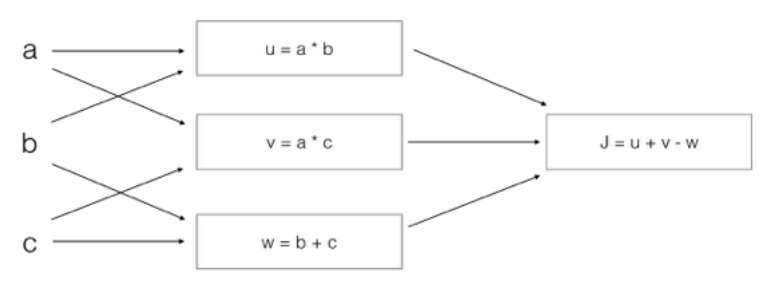(1)What does a neuron compute?
[A]A neuron computes an activation function followed by a linear function(z=Wx+b)
[B]A neuron computes the mean of all features before applying the output to an activation function.
[C]A neuron computes a linear function(z=Wx+b) followed by an activation function.
[D]A neuron computes a function g that scales the input x linearly(Wx+b)
答案:C
解析:如图所示

(2)Which of these is the “Logistic Loss”?
[A]
L
(
i
)
(
y
^
(
i
)
,
y
(
i
)
)
=
∣
y
(
i
)
−
y
^
(
i
)
∣
2
L^{(i)} (\hat{y}^{(i)},y^{(i)})=|y^{(i)}-\hat{y}^{(i)}|^2
L(i)(y^(i),y(i))=∣y(i)−y^(i)∣2
[B]
L
(
i
)
(
y
^
(
i
)
,
y
(
i
)
)
=
m
a
x
(
0
,
y
(
i
)
−
y
^
(
i
)
)
L^{(i)} (\hat{y}^{(i)},y^{(i)})=max(0,y^{(i)}-\hat{y}^{(i)})
L(i)(y^(i),y(i))=max(0,y(i)−y^(i))
[C]
L
(
i
)
(
y
^
(
i
)
,
y
(
i
)
)
=
∣
y
(
i
)
−
y
^
(
i
)
∣
L^{(i)} (\hat{y}^{(i)},y^{(i)})=|y^{(i)}-\hat{y}^{(i)}|
L(i)(y^(i),y(i))=∣y(i)−y^(i)∣
[D]
L
(
i
)
(
y
^
(
i
)
,
y
(
i
)
)
=
−
y
(
i
)
log
(
y
^
(
i
)
)
+
(
1
−
y
(
i
)
)
log
(
1
−
y
^
(
i
)
)
L^{(i)} (\hat{y}^{(i)},y^{(i)})=-y^{(i)}\log{(\hat{y}^{(i)}})+(1-y^{(i)})\log{(1-\hat{y}^{(i)}})
L(i)(y^(i),y(i))=−y(i)log(y^(i))+(1−y(i))log(1−y^(i))
答案:D
(3)Suppose img is a (32,32,3) array, representing a 32x32 image with 3 color channels red, green and blue. How do you reshape this into a column vector?
[A] x = img.reshape((32*32*3,1))
[B] x = img.reshape((1,32*32*3))
[C] x = img.reshape((3,32*32))
[C] x = img.reshape((32*32,3))
答案:A
解析:注意,题目要求列向量(column vector)
(4)Consider the two following random arrays “a” and “b”:
a = np.random.randn(2,3) # a.shape = (2,3)
b = np.random.randn(2,1) # a.shape = (2,1)
c = a+b
What will be the shape of “c”?
[A] c.shape = (2,1)
[B] c.shape = (3,2)
[C] c.shape = (2,3)
[D] The computation cannot happen because the size don’t match. It’s going to be “Error” !
答案:C
解析:Broadcasting
(5)Consider the two following random arrays “a” and “b”:
a = np.random.randn(4,3) # a.shape = (4,3)
b = np.random.randn(3,2) # a.shape = (3,2)
c = a*b
What will be the shape of “c”?
[A] c.shape = (3,3)
[B] c.shape = (4,2)
[C] c.shape = (4,3)
[D] The computation cannot happen because the size don’t match. It’s going to be “Error” !
答案:D
解析:对于ndarray,*运算符为元素乘法,matmul为矩阵乘法。
(6)Suppose you have
n
x
n_x
nx input features per example. Recall that
X
=
[
x
(
1
)
,
x
(
2
)
.
.
.
x
(
m
)
]
X=[x^{(1)},x^{(2)}...x^{(m)}]
X=[x(1),x(2)...x(m)].What is the dimension of X?
[A]
(
1
,
m
)
(1,m)
(1,m)
[B]
(
m
,
1
)
(m,1)
(m,1)
[C]
(
x
x
,
m
)
(x_x,m)
(xx,m)
[D]
(
m
,
n
x
)
(m,n_x)
(m,nx)
答案:C
(7)Recall that “np.dot(a,b)” performs a matrix multiplication on a and b, whereas “a*b” performs an element-wise multiplication.
Consider the two following random arrays “a” and “b” .
a = np.random.randn(12288,150) # a.shape = (12288,150)
b = np.random.randn(150,45) # a.shape = (150,45)
c = np.dot(a,b)
What will be the shape of “c”?
[A] c.shape = (150,150)
[B] c.shape = (12288,150)
[C] c.shape = (12288,45)
[D] The computation cannot happen because the size don’t match. It’s going to be “Error” !
答案:C
(8)Consider the following code snippet:
# a.shape = (3,4)
# b.shape = (4,1)
for i in range(3):
for j in range(4):
c[i][j]=a[i][j]+b[j]
How do you vectorize this?
[A] c = a.T + b.T
[B] c = a.T + b
[C] c = a + b.T
[D] c = a + b
答案:C
(9)Consider the following code:
a = np.random.randn(3,3)
b = np.random.randn(3,1)
c = a*b
What will be c?(If you’re not sure, feel free to run this in python to find out).
[A]This will invoke broadcasting, so b is copied three times to become (3,3), and * is an element-wise product so c.shape will be (3,3)
[B]This will invoke broadcasting, so b is copied three times to become (3,3), and * invokes a matrix multiplication operation of two 3x3 matrices so c.shape will be (3,3)
[C]This will multiply a 3x3 matrix a with a 3x1 vector, thus resulting in a 3x1 vector. That is, c.shape = (3,1)
[D]It will lead to an error since you cannot use “*” to operate on these two matrices. You need to instead use np.dot(a,b)
答案:A
(10)Consider the following computation graph.

What is the output J?
[A]
J
=
(
c
−
1
)
∗
(
b
+
a
)
J=(c-1)*(b+a)
J=(c−1)∗(b+a)
[B]
J
=
(
a
−
1
)
∗
(
b
+
c
)
J=(a-1)*(b+c)
J=(a−1)∗(b+c)
[C]
J
=
a
∗
b
+
b
∗
c
+
a
∗
c
J=a*b+b*c+a*c
J=a∗b+b∗c+a∗c
[D]
J
=
(
b
−
1
)
∗
(
c
+
a
)
J=(b-1)*(c+a)
J=(b−1)∗(c+a)
答案:B
解析:
J
=
u
+
v
−
w
=
a
∗
b
+
a
∗
c
−
(
b
+
c
)
=
a
∗
(
b
+
c
)
−
(
b
+
c
)
=
(
a
−
1
)
∗
(
b
+
c
)
\begin{aligned} J & =u+v-w \\ &= a*b+a*c-(b+c) \\ &= a*(b+c)-(b+c) \\ &= (a-1)*(b+c) \end{aligned}
J=u+v−w=a∗b+a∗c−(b+c)=a∗(b+c)−(b+c)=(a−1)∗(b+c)






















 337
337











 被折叠的 条评论
为什么被折叠?
被折叠的 条评论
为什么被折叠?








